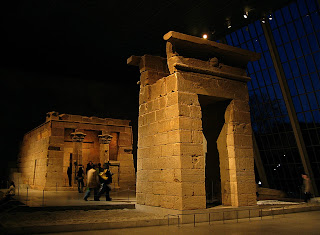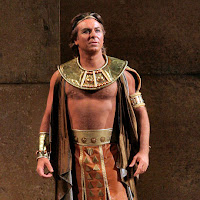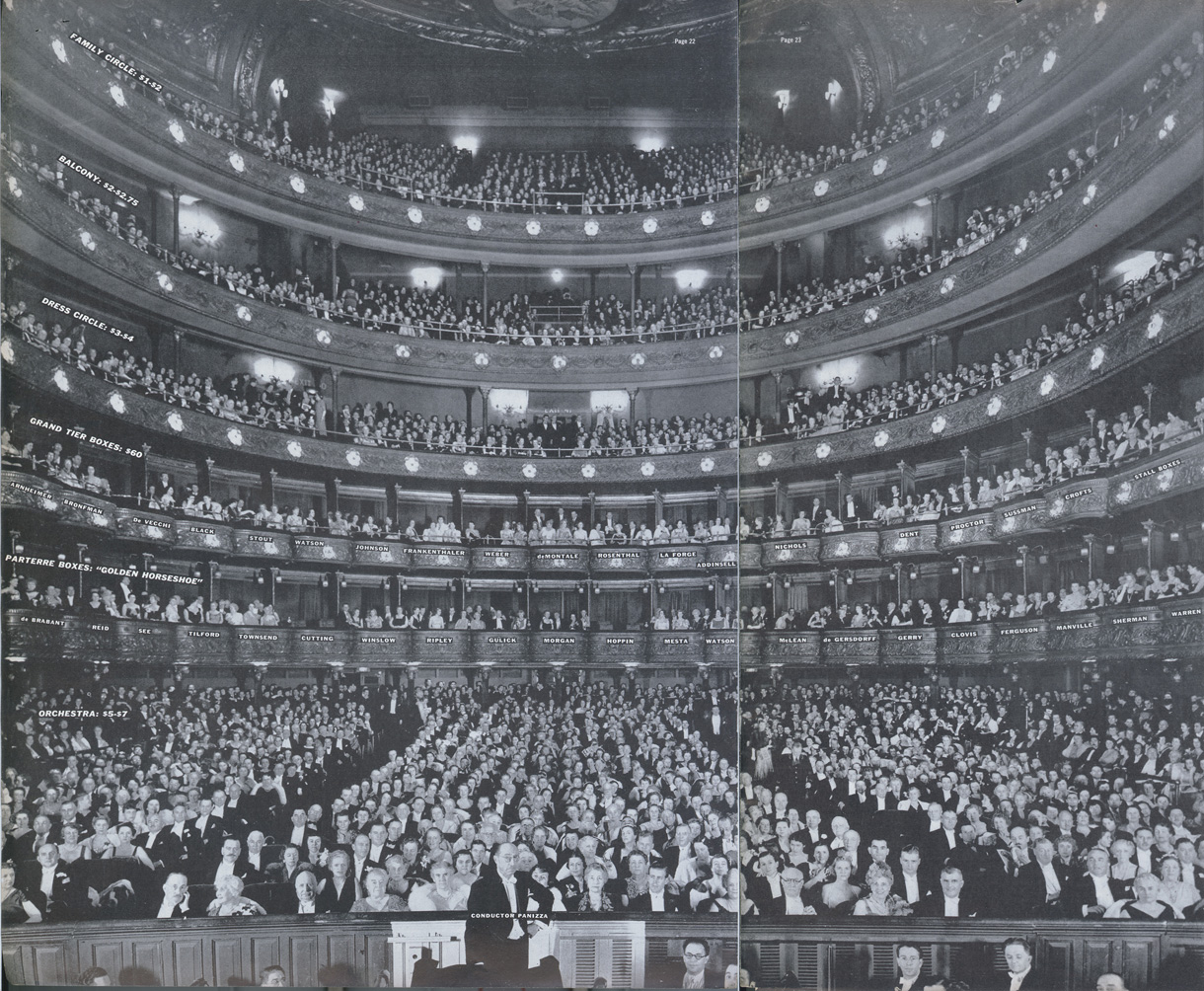This week was my first Aida at the Met–my first Aida being in Syracuse, NY (it’s a long story). Aida is the third Verdi opera I have seen at the Met after Macbeth last year and Ballo last month. Both Macbeth and Ballo were notoriously “modernized” productions so Aida was the first period Verdi I have seen and it was perfect for this. The towering Egyptian sets, traditional dress and extended Triumphal March were sure to be a pleasant departure from the leather jackets, machine guns or pepperpot witches and gypsies of my previous Verdi Met experiences.
I knew we were in for a great evening even before the show started when we ran into a 70-something year old woman on the grand staircase in a hot pink negligee, wearing a diamond tiara, breasts lifted up under her chin and spilling out the top of her dress. Watching her lurch down the stairs in her five-inch heels, and surveying the scene of everyone wearing their best clothes (of course, with a wide range of “best”), I could tell the operagoers had high expectations for the night.
 The sets were dazzling as expected. However while admiring them, I was led to my first question about the production. All of the costumes were bright and brand spanking new looking but the Egyptian architecture onstage was decayed. It looked thousands of years old, like it came right out of the Met Museum. Had someone told me that they borrowed the set from the Met Museum, I would not have been surprised. Yet the action in the opera is occurring thousands of years ago so should not the architecture be far newer looking? Or even brand new? And did not the ancient Egyptians paint their statuary? Paint that has long ago faded or dissolved by the time it gets to the museum where we see it for the first time?
The sets were dazzling as expected. However while admiring them, I was led to my first question about the production. All of the costumes were bright and brand spanking new looking but the Egyptian architecture onstage was decayed. It looked thousands of years old, like it came right out of the Met Museum. Had someone told me that they borrowed the set from the Met Museum, I would not have been surprised. Yet the action in the opera is occurring thousands of years ago so should not the architecture be far newer looking? Or even brand new? And did not the ancient Egyptians paint their statuary? Paint that has long ago faded or dissolved by the time it gets to the museum where we see it for the first time? I mentioned this to my fiancé who said when he was young, he had the same question for his father, a baritone who has performed in Aida many times. His father had answered that even though historically this was true, if all the architecture were highly painted and colorful it would look too much like the production had been “bought at the Egypt Store” and that the decayed architecture more readily transports a modern eye to the idea of ancient Egypt than bright colors and pristine statuary would. I realized that I ultimately agreed with this. Who am I to argue with the King of Ethiopia anyway?
Aida was also interesting in that it was the first opera I have seen with so many long purely orchestral sections. This of course allowed for many of the spectacular theatrical moments like the live horses bringing the victors home from war. But during one of those orchestral sections, I did find myself wondering about the ballet interlude. Does anyone else find it odd that an opera taking place in ancient Egypt is sung in Italian and has a ballet sequence?
But overall the show was great. As I said the production is spectacular, at times breathtaking. The singers were all solid. Roberto Alagna, whom I have seen several times now, does always make me anxious for some reason. I always fear he’s not going to make it. He always does, but just something about him makes me fear for him. The orchestra sounded great. My best musical experiences at the Met in the last 14 months have all come under Fabio Luisi.
 The audial effect we heard in Elisir still remains. There are huge spikes in the volume and clarity of the vocal sound depending where the singers are onstage. I no longer think it is an amplification system just SUPER sweet acoustical spots on the stage. Downstage left seems to be the sweetest, at least from where we are sitting in second row dress circle. But anything is possible of course.
The audial effect we heard in Elisir still remains. There are huge spikes in the volume and clarity of the vocal sound depending where the singers are onstage. I no longer think it is an amplification system just SUPER sweet acoustical spots on the stage. Downstage left seems to be the sweetest, at least from where we are sitting in second row dress circle. But anything is possible of course.
 I really do like Alagna. He has never let us down and is always committed, likable and vocally on the money. Perhaps, I’ve been subconsciously afraid he will be skewered by a sliver of faux gold leaf from the ceiling during a high note. We shall see. I will keep an eye on the ceilings.
I really do like Alagna. He has never let us down and is always committed, likable and vocally on the money. Perhaps, I’ve been subconsciously afraid he will be skewered by a sliver of faux gold leaf from the ceiling during a high note. We shall see. I will keep an eye on the ceilings. – Elizabeth Frayer and Shawn E Milnes
Related Articles-




Every time I see a Met production in HD at the movie theater and Alagna is singing, it always strikes me that he spends a lot of time singing with his eyes closed. What’s up with that? Is he trying to compete with Andrea Bocelli and con us into thinking he’s blind? Is he mentally picturing the words so he won’t have a memory lapse? Does he simply find sopranos (other than his wife) repulsive and wish to get through love duets without gagging? I wonder if anyone else is bothered by this….